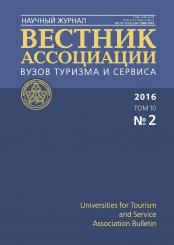Аbstract. The aim of this paper is to identify why independent hotels decide to affiliate and give up their highly valued independence. Based on interviews with 12 independently owned hotels and five affiliations active on the Swedish market, it became evident that independence is important, but factors such as development with technical solutions, internet, the use of smart phones, social media, sales and marketing, central purchasing and loyalty cards are difficult to pursue as an independent hotel. The results also showed that marketing organisations and referral chains are the preferred options, as their offerings are more in line with the view of strategic entrepreneurship that the hoteliers expressed. Even agencyrelated aspects such as control rights affected the entrepreneurs’ aspiration to affiliate, at the same time as the respondents thought their way of running the business was the most efficient. The results from the research add to the knowledge associated with agency theory, strategic entrepreneurship and resource-based view of the firm. More practically, it gives the independent hoteliers a possibility to assess the current situation and decide what options could be valuable, while the affiliations would be able to better align their offerings to attract new hotels.
hospitality industry, strategic entrepreneurship, affiliations, growth, hotels, Sweden
To be or not to be affiliated is a much discussed and debated topic in today’s hospitality industry. Both for restaurants and hotels, the presence of chains, affiliations and franchise operations, both smaller and larger, are becoming increasingly dominant.
1. Abdellatif, M., Amann, B., & Jaussaud, J. (2010). Family versus non-family business: A comparison of international strategies. Journal of Family Business Strategy, 2010(16), 108-116. doi:10.1016/ j.jfbs.2010.04.004.
2. Alma, H. (2007). Unchained ideology (Master thesis no. 2007:35). School of Business, Economics and Law, University of Gothenburg, Gothenburg, Sweden, 105.
3. Andersson, T.D., Carlsen, J., & Getz, D. (2002). Family business goals in the tourism and hospitality sector: Case studies and cross-case analysis from Australia, Canada, and Sweden. Family Business Review, 15(2), 89-106. doihttps://doi.org/10.1111/j.1741-6248.2002.00089.
4. Ang, J.S., Cole, R.A., & Wuh Lin, J. (2000). Agency costs and ownership structure. The Journal of Finance, 55(1), 81-106. doihttps://doi.org/10.1111/0022-1082.00201.
5. Anson, W. (2001). Building the value of hospitality brands. Licensing Journal, 27(6), 35.
6. Astrachan, J.H. (2010). Strategy in family business: Toward a multidimensional research agenda. Journal of Family Business Strategy, 1(1), 6-14. doihttps://doi.org/10.1016/j.jfbs.2010.02.001.
7. Astrachan, J.H., & Shanker, M.C. (2003). Family businesses’ contribution to the U.S. economy: A closer look. Family Business Review, 16(3), 211-219. doihttps://doi.org/10.1177/08944865030160030601.
8. Axberg, C. (1996). Franchising i Sverige (Vol. 1). Stra¨ngna¨s: Effectum Franchise Consulting.
9. Bailey, R. (2007). UK hotel industry brand equity: Its meaning and uses for brand management. Sheffield: Sheffield Hallam University.
10. Bailey, R., & Ball, S. (2006). An exploration of the meanings of hotel brand equity. The Service Industries Journal, 26(1),15-38. doihttps://doi.org/10.1080/02642060500358761.
11. Bohdanowicz, P., & Zientara, P. (2008). Corporate social responsibility in hospitality: Issues and implications. A case study of Scandic. Scandinavian Journal of Hospitality and Tourism, 8(4), 271-293. doihttps://doi.org/10.1080/15022250802504814.
12. Brown, J.R., & Dev, C.S. (1999). Looking beyond RevPAR: Productivity consequences of hotel strategies. Cornell Hotel and Restaurant Administration Quarterly, 40(2), 23-33. doihttps://doi.org/10.1177/001088049904000213.
13. Chan, E. (2011). Implementing environmental management systems in small- and medium-sized hotels: Obstacles. Journal of Hospitality & Tourism Research, 35(1), 3-23. doihttps://doi.org/10.1177/1096348010370857.
14. Christian, R. (2001). Developing an online access strategy: Issues facing small to medium-sized tourism and hospitality enterprises. Journal of Vacation Marketing, 7(2), 170-178. doi: 10.1177/ 135676670100700206.
15. Damonte, L.T., Rompf, P.D., Domke, D.J., & Bahl, R. (1997). Brand affiliation and property size effects on measures of performance in lodging properties. Hospitality Research Journal, 20(3), 1-16.
16. Dittman, D.A., Hesford, J.W., & Potter, G. (2009). Managerial accounting in the hospitality industry. In C.S. Chapman, A.G. Hopwood, & M.D. Shields (Eds.), Handbook of management accounting research (pp. 1353-1369). New York: Elsevier.
17. Eisenhardt, K.M. (1989). Agency theory: An assessment and review. The Academy of Management Review, 14(1), 57-74.
18. Espino-Rodrı´guez, T.F., & Padro´n-Robaina, V. (2004). A resource-based view of outsourcing and its Implications for organizational performance in the hotel sector. Tourism Management, 26(5), 707-721. doihttps://doi.org/10.1016/j.tourman.2004.03.013.
19. Getz, D., & Petersen, T. (2005). Growth and profit-oriented entrepreneurship among family business owners in the tourism and hospitality industry. International Journal of Hospitality Management, 2005(24), 219-242. doihttps://doi.org/10.1016/j. ijhm.2004.06.007.
20. Hart, O. (2001). Financial contracting. Journal of Economic Literature, XXXIX (December), 1079-1110.
21. Imrie, R., & Fyall, A. (2001). Independent mid-market UK hotels: Marketing strategies for an increasingly competitive environment. Journal of Vacation Marketing, 7(63), 63-74. doihttps://doi.org/10.1177/135676670100700106.
22. Ireland, R.D., & Hitt, M.A. (1999). Achieving and maintaining strategic competitiveness in the 21st century. Academy of Management Executive, 13(1), 43-57. doihttps://doi.org/10.5465/AME.1999.1567311.
23. Ireland, R.D., & Webb, J.W. (2007). Strategic entrepreneurship: Creating competitive advantage through streams of innovation. Business Horizons, 15(1), 49-59. doihttps://doi.org/10.1016/j.bushor.2006.06.002.
24. Jensen, M. (1983). Organization theory and methodology. Accounting Review, 56, 319-338.
25. Jensen, M., & Meckling, W. (1976). Theory of the firm: Managerial behaviour, agency costs, and ownership structure. Journal of Financial Economics, 3, 305-360. doihttps://doi.org/10.1016/0304-405X(76)90026-X.
26. Lamminmaki, D. (2006). Outsourcing in the hotel industry: A management accounting perspective. Oxford: Butterworth-Heinemann.
27. Lamminmaki, D. (2011). An examination of factors motivating hotel outsourcing. International Journal of Hospitality Management, 30(4), 963-973. doihttps://doi.org/10.1016/j.ijhm.2010.10.010.
28. Mieyal Higgins, S. (2006). Independents relish individuality (Cover story). Hotel & Motel Management, 221(21), 1-38.
29. Moores, K. (2009). Paradigms and theory building in the domain of business families. Family Business Review, 22(2), 167-180. doihttps://doi.org/10.1177/0894486509333372.
30. Oh, H., & Kim, B.Y. (2004). How do hotel firms obtain a competitive advantage? International Journal of Contemporary Hospitality Management, 16(1), 65-71. doihttps://doi.org/10.1108/09596110410516589.
31. O’Neill, J.W., & Carlba¨ck, M. (2011). Do brands matter? A comparison of branded and independent hotels’ performance during a full economic cycle. International Journal of Hospitality Management, 30(3), 515-521. doihttps://doi.org/10.1016/j. ijhm.2010.08.003.
32. O’Neill, J.W., & Mattila, A.S. (2010). Hotel brand strategy. Cornell Hospitality Quarterly, 51(1), 27-34. doihttps://doi.org/10.1177/1938965509352286.
33. O’Neill, J.W., & Xiao, Q. (2006). The role of brand affiliation in hotel market value. Cornell Hotel and Restaurant Administration Quarterly, 47(3), 210-223. doihttps://doi.org/10.1177/0010880406289070.
34. Ottenbacher, M., & Gnoth, J. (2005). How to develop successful hospitality innovation. Cornell Hotel and Restaurant Administration Quarterly, 46(2), 205-222. doihttps://doi.org/10.1177/0010880404271097.
35. Rushmore, S. (2001a, September). Six things to consider before obtaining a hotel franchise. Hotels, p. 30.
36. Rushmore, S. (2001b, June). What do hotel franchises actually cost? Hotels, p. 36.
37. Rushmore, S. (2004, February). A case for being independent. Hotels, p. 22.
38. Schulze, W.S., Lubatkin, M.H., Dino, R.N., & Buchholtz, A.K. (2001). Agency relationships in family firms: Theory and evidence. Organizational Science, 12(2), 99-116. doihttps://doi.org/10.1287/orsc.12.2.99.10114.
39. Scoviak, M. (2007). Full throttle franchising. Hotels, 41(10), 39-40.
40. Shaw, G., & Williams, A. (1990). Entrepreneurship, small businesses, culture and tourism development (Vol. 2). London: Belhaven Press.
41. SHR. (2010). SHR: s Nyckeltalsunderso¨kning 2010. Stockholm, Sweden: Visita.
42. Siguaw, J.A., Enz, C.A., & Namasivayam, K. (2000). Adoption of information technology in U.S. hotels: Strategically driven objectives. Journal of Travel Research, 39(2), 192-201. doi:10.1177/ 004728750003900209.
43. Smith, N.R. (1967). The entrepreneur and his firm: The relationship between type of man and type of company. East Lansing: Michigan State University, Bureau of Business and Economic Research.
44. Tollington, T. (2002). Brand assets. Chichester: John Wiley & Sons.
45. Webb, J., Ketchen, D., & Ireland, R. (2010). Strategic entrepreneurship within family-controlled firms: Opportunities and challenges. Journal of Family Business Strategy, 2010(1), 67-77. doi:10.1016/ j.jfbs.2010.04.002.
46. Wu, S.I., & Li, P.C. (2010). The relationships between CRM, RQ, and CLV based on different hotel preferences. International Journal of Hospitality Management, 30(2), 262-271. doi:10.1016/ j.ijhm.2010.09.011.





